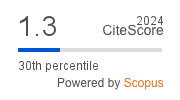Fungistatic effect of Gracilaria verrucosa on phospholipase enzymes and the cell surface hydrophobicity of Candida albicans
Downloads
Background: Candida albicans (C. albicans) was reported as a primary cause of oral candidiasis. Phospholipase enzymes and cell surface hydrophobicity (CSH) are involved in the pathogenesis of its infection. Gracilaria verrucosa (G. verrucosa) is reported to contain flavonoids, tannins, and phenolic compounds, which can inhibit the development of C. albicans. Purpose: The study analyzed the effect of the ethanol extract of G. verrucosa on the inhibition of the phospholipase enzyme and CSH of C. albicans. Methods: The G. verrucosa chemical compounds were examined by phytochemical tests and phospholipase enzyme-inhibiting egg yolk media, and a CSH assay was conducted using xylene. Results: Gracilaria verrucosa contains steroids, terpenoids, tannins/phenolics, and flavonoids. The 25%–100% concentrations inhibit the phospholipase enzyme of C. albicans more strongly at 48 hours than at 12 hours and 24 hours (p < 0.05). Furthermore, the 100% and 75% concentrations substantially affect the inhibition of CSH of C. albicans, with a strong relationship. Conclusion: Gracilaria verrucosa has a more substantial inhibitory effect in suppressing the phospholipase enzyme and CSH of C. albicans.
Downloads
Gani BA, Bachtiar EW, Bachtiar BM. The role of cigarettes smoke condensatein enhanced candida albicans virulence of salivary isolates based on time and temperature. J Int Dent Med Res. 2017; 10(Special Issue): 769–77. web: http://www.jidmr.com/journal/wp-content/uploads/2017/12/64.16Basri-et-al-rev.pdf
Lim SJ, Mohamad Ali MS, Sabri S, Muhd Noor ND, Salleh AB, Oslan SN. Opportunistic yeast pathogen Candida spp.: Secreted and membrane-bound virulence factors. Med Mycol. 2021; 59(12): 1127–44. doi: https://doi.org/10.1093/mmy/myab053
Deng J, Lu Z, Wang H, Li N, Song G, Zhu Q, Sun J, Zhang Y. A secretory phospholipase A2 of a fungal pathogen contributes to lipid droplet homeostasis, assimilation of insect‐derived lipids, and repression of host immune responses. Insect Sci. 2022; 29(6): 1685–702. doi: https://doi.org/10.1111/1744-7917.13029
Triawan A, Pudyani PS, HNE SM, - S. The effect of nanochitosan hydrogel membrane on absorbtion of nickel, inhibition of Streptococcus mutans and Candida albicans. Dent J (Majalah Kedokt Gigi). 2015; 48(1): 26. doi: https://doi.org/10.20473/j.djmkg.v48.i1.p26-30
Ali U, Lu S, Fadlalla T, Iqbal S, Yue H, Yang B, Hong Y, Wang X, Guo L. The functions of phospholipases and their hydrolysis products in plant growth, development and stress responses. Prog Lipid Res. 2022; 86(January): 101158. doi: https://doi.org/10.1016/j.plipres.2022.101158
Wilson SK, Knoll LJ. Patatin‐like phospholipases in microbial infections with emerging roles in fatty acid metabolism and immune regulation by Apicomplexa. Mol Microbiol. 2018; 107(1): 34–46. doi: https://doi.org/10.1111/mmi.13871
Cauchie M, Desmet S, Lagrou K. Candida and its dual lifestyle as a commensal and a pathogen. Res Microbiol. 2017; 168(9–10): 802–10. doi: https://doi.org/10.1016/j.resmic.2017.02.005
El-Houssaini HH, Elnabawy OM, Nasser HA, Elkhatib WF. Correlation between antifungal resistance and virulence factors in Candida albicans recovered from vaginal specimens. Microb Pathog. 2019; 128: 13–9. doi: https://doi.org/10.1016/j.micpath.2018.12.028
Abraham SB, al Marzooq F, Himratul-Aznita WH, Ahmed HMA, Samaranayake LP. Prevalence, virulence and antifungal activity of C. albicans isolated from infected root canals. BMC Oral Health. 2020; 20(1): 347. doi: https://doi.org/10.1186/s12903-020-01347-5
Jabra-Rizk MA, Falkler WA, Merz WG, Baqui AA, Kelley JI, Meiller TF. Cell surface hydrophobicity-associated adherence of Candida dubliniensis to human buccal epithelial cells. Rev Iberoam Micol. 2001; 18(1): 17–22. pubmed: https://pubmed.ncbi.nlm.nih.gov/15482009/
Atriwal T, Azeem K, Husain FM, Hussain A, Khan MN, Alajmi MF, Abid M. Mechanistic understanding of Candida albicans biofilm formation and approaches for its inhibition. Front Microbiol. 2021; 12: 638609. doi: https://doi.org/10.3389/fmicb.2021.638609
Rajkowska K, Kunicka-Styczyńska A, Pęczek M. Hydrophobic properties of Candida spp. under the influence of selected essential oils. Acta Biochim Pol. 2015; 62(4): 663–8. doi: https://doi.org/10.18388/abp.2015_1096
Macias-Paz IU, Pérez-Hernández S, Tavera-Tapia A, Luna-Arias JP, Guerra-Cárdenas JE, Reyna-Beltrán E. Candida albicans the main opportunistic pathogenic fungus in humans. Rev Argent Microbiol. 2023; 55(2): 189–98. doi: https://doi.org/10.1016/j.ram.2022.08.003
Rezeki S, Pradono SA, Subita GP, Rosana Y, Sunnati S, Gani BA. The antifungal susceptibility of Candida albicans isolated from HIV/AIDS patients. Dent J. 2021; 54(2): 82–6. doi: https://doi.org/10.20473/J.DJMKG.V54.I2.P82-86
Garcia-Cuesta C, Sarrion-Perez M, Bagan J. Current treatment of oral candidiasis: A literature review. J Clin Exp Dent. 2014; 6(5): e576–82. doi: https://doi.org/10.4317/jced.51798
Seleem D, Pardi V, Murata RM. Review of flavonoids: A diverse group of natural compounds with anti-Candida albicans activity in vitro. Arch Oral Biol. 2017; 76: 76–83. doi: https://doi.org/10.1016/j.archoralbio.2016.08.030
Widowati I, Lubac D, Puspita M, Bourgougnon N. Antibacterial and antioxidant properties of the red alga Gracilaria verrucosa from the North Coast of Java, Semarang, Indonesia. Int J Latest Res Sci Technol. 2014; 3(3): 179–85. web: https://www.mnkjournals.com/journal/ijlrst/Article.php?paper_id=10337
Noviyandri PR, , N, Chismirina S. Effect of Nutmeg Flesh (Myristica fragrans Houtt) against Streptococcus mutans growth. J Syiah Kuala Dent Soc. 2021; 5(1): 42–6. doi: https://doi.org/10.24815/jds.v5i1.19682
Dohude GA, Rusdy H, Hanafiah OA, Johal PK. Inhibitory test of turmeric leaves extract (Curcuma Longa. L) against the growth of Streptococcus mutans bacterial growth in vitro. J Syiah Kuala Dent Soc. 2023; 7(2): 73–7. doi: https://doi.org/10.24815/jds.v7i2.30229
Soraya C, Mubarak Z, Gani BA. The growth and biofilm formation of Enterococcus faecalis in ethanol extract of Citrus aurantiifolia Indonesian species. J Pharm Pharmacogn Res. 2020; 8(1): 558–68. doi: https://doi.org/10.56499/jppres20.895_8.6.558
Muadcheingka T, Tantivitayakul P. Distribution of Candida albicans and non-albicans Candida species in oral candidiasis patients: Correlation between cell surface hydrophobicity and biofilm forming activities. Arch Oral Biol. 2015; 60(6): 894–901. doi: https://doi.org/10.1016/j.archoralbio.2015.03.002
Duru IA, Maduka TD-O. Profiling and comparison of fatty acids in the oils from the fruits of Dacryodes edulis and Canarium schweinfurthii. J Med Plants Stud. 2020; 8(5): 213–7. doi: https://doi.org/10.22271/plants.2020.v8.i5c.1217
Chukwuma IF, Apeh VO, Nworah FN, Nkwocha CC, Emaimo J, Ezeanyika LUS, Ogugua VN. Inhibition of phospholipase A2 and prostaglandin synthase activities as possible mechanistic insight into the anti-inflammatory activity of Brenania brieyi methanol and chloroform fractions. Thai J Pharm Sci. 2022; 46(1): 75–84. doi: https://doi.org/10.56808/3027-7922.2548
Mubarak Z, Humaira A, Gani BA, Muchlisin ZA. Preliminary study on the inhibitory effect of seaweed Gracilaria verrucosa extract on biofilm formation of Candida albicans cultured from the saliva of a smoker. F1000Research. 2018; 7: 684. doi: https://doi.org/10.12688/f1000research.14879.3
Bu Q-R, Bao M-Y, Yang Y, Wang T-M, Wang C-Z. Targeting virulence factors of Candida albicans with natural products. Foods. 2022; 11(19): 2951. doi: https://doi.org/10.3390/foods11192951
Hans S, Fatima Z, Hameed S. Metabolic fitness of Candida albicans is indispensable for functional drug efflux, ergosterol, and chitin biosynthesis. Curr Med Mycol. 2020; 6(3): 9–14. doi: https://doi.org/10.18502/cmm.6.3.3980
Prabajati R, Hernawan I, Hendarti HT. Effects of citrus limon essential oil (Citrus limon L.) on cytomorphometric changes of Candida albicans. Dent J (Majalah Kedokt Gigi). 2017; 50(1): 43. doi: https://doi.org/10.20473/j.djmkg.v50.i1.p43-48
Santos ALS, Braga-Silva LA, Gonçalves DS, Ramos LS, Oliveira SSC, Souza LOP, Oliveira VS, Lins RD, Pinto MR, Muñoz JE, Taborda CP, Branquinha MH. Repositioning lopinavir, an HIV protease inhibitor, as a promising antifungal drug: Lessons learned from Candida albicans—in silico, in vitro and in vivo approaches. J Fungi. 2021; 7(6): 424. doi: https://doi.org/10.3390/jof7060424
Wang L, Hu C, Shao L. The antimicrobial activity of nanoparticles: Present situation and prospects for the future. Int J Nanomedicine. 2017; 12: 1227–49. doi: https://doi.org/10.2147/IJN.S121956
Ordoñez R, Atarés L, Chiralt A. Biodegradable active materials containing phenolic acids for food packaging applications. Compr Rev Food Sci Food Saf. 2022; 21(5): 3910–30. doi: https://doi.org/10.1111/1541-4337.13011
Alfarrayeh IIS. Bioactivities and potential beneficial properties of propolis ethanolic extract, caffeic acid phenethyl ester, and Arabic coffee beans extract. Thesis: University of Pécs; 2021. p. 1–14. web: https://pea.lib.pte.hu/handle/pea/24603
Salehi, Sharifi-Rad, Seca, Pinto, Michalak, Trincone, Mishra, Nigam, Zam, Martins. Current trends on seaweeds: looking at chemical composition, phytopharmacology, and cosmetic applications. Molecules. 2019; 24(22): 4182. doi: https://doi.org/10.3390/molecules24224182
Sebaa S, Hizette N, Boucherit-Otmani Z, Courtois P. Dose-dependent effect of lysozyme upon Candida albicans biofilm. Mol Med Rep. 2017; 15(3): 1135–42. doi: https://doi.org/10.3892/mmr.2017.6148
Tyagi S, Lee K-J, Shukla P, Chae J-C. Dimethyl disulfide exerts antifungal activity against Sclerotinia minor by damaging its membrane and induces systemic resistance in host plants. Sci Rep. 2020; 10(1): 6547. doi: https://doi.org/10.1038/s41598-020-63382-0
Alam M, Bano N, Ahmad T, Sharangi AB, Upadhyay TK, Alraey Y, Alabdallah NM, Rauf MA, Saeed M. Synergistic role of plant extracts and essential oils against multidrug resistance and gram-negative bacterial strains producing extended-spectrum β-lactamases. Antibiotics. 2022; 11(7): 855. doi: https://doi.org/10.3390/antibiotics11070855
Liu X-Y, Huo Y-Y, Yang J, Li T-T, Xu F-R, Wan H-P, Li J-N, Wu C-H, Zhang Y-H, Dong X. Integrated physiological, metabolomic, and proteome analysis of Alpinia officinarum Hance essential oil inhibits the growth of Fusarium oxysporum of Panax notoginseng. Front Microbiol. 2022; 13: 1031474. doi: https://doi.org/10.3389/fmicb.2022.1031474
Kaskatepe B, Aslan Erdem S, Ozturk S, Safi Oz Z, Subasi E, Koyuncu M, Vlainić J, Kosalec I. Antifungal and anti-virulent activity of Origanum majorana L. Essential oil on Candida albicans and in vivo toxicity in the Galleria mellonella Larval model. Molecules. 2022; 27(3): 663. doi: https://doi.org/10.3390/molecules27030663
Muszewska A, Piłsyk S, Perlińska-Lenart U, Kruszewska J. Diversity of cell wall related proteins in human pathogenic fungi. J Fungi. 2017; 4(1): 6. doi: https://doi.org/10.3390/jof4010006
Garcia-Rubio R, de Oliveira HC, Rivera J, Trevijano-Contador N. The fungal cell wall: Candida, Cryptococcus, and Aspergillus species. Front Microbiol. 2019; 10: 2993. doi: https://doi.org/10.3389/fmicb.2019.02993
Bouchelaghem S. Antimicrobial and antibiofilm activities of Hungarian propolis on Candida albicans and Staphylococcus aureus and its mechanism of action. Thesis: University of Pécs; 2022. p. 1–15. web: http://pea.lib.pte.hu/handle/pea/34250
Ropponen H-K, Richter R, Hirsch AKH, Lehr C-M. Mastering the Gram-negative bacterial barrier – Chemical approaches to increase bacterial bioavailability of antibiotics. Adv Drug Deliv Rev. 2021; 172: 339–60. doi: https://doi.org/10.1016/j.addr.2021.02.014
Ghedifa A Ben, Vega J, Korbee N, Mensi F, Figueroa FL, Sadok S. Effects of light quality on the photosynthetic activity and biochemical composition of Gracilaria gracilis (Rhodophyta). J Appl Phycol. 2021; 33(5): 3413–25. doi: https://doi.org/10.1007/s10811-021-02496-y
Hemmati S, Rasekhi Kazerooni H. Polypharmacological cell-penetrating peptides from venomous marine animals based on immunomodulating, antimicrobial, and anticancer properties. Mar Drugs. 2022; 20(12): 763. doi: https://doi.org/10.3390/md20120763
Copyright (c) 2025 Dental Journal

This work is licensed under a Creative Commons Attribution-ShareAlike 4.0 International License.
- Every manuscript submitted to must observe the policy and terms set by the Dental Journal (Majalah Kedokteran Gigi).
- Publication rights to manuscript content published by the Dental Journal (Majalah Kedokteran Gigi) is owned by the journal with the consent and approval of the author(s) concerned.
- Full texts of electronically published manuscripts can be accessed free of charge and used according to the license shown below.
- The Dental Journal (Majalah Kedokteran Gigi) is licensed under a Creative Commons Attribution-ShareAlike 4.0 International License

















